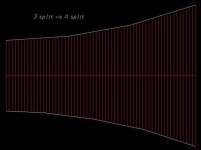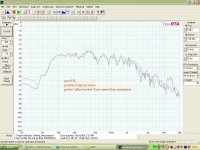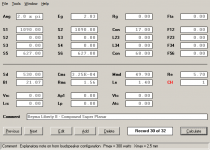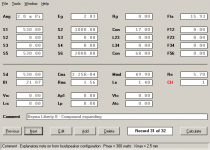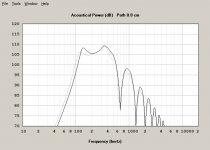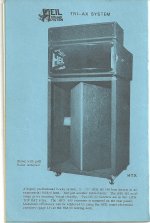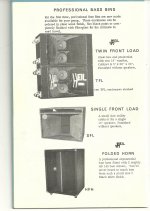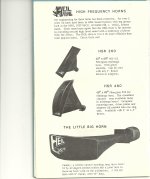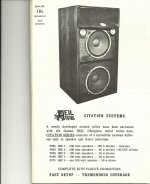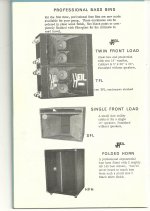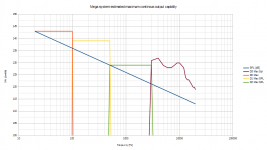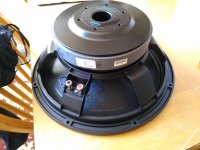When I built my 80Hz midbass horns I modelled a fully curved sides / straight conical hypex versus 'stepped' curved sides / straight conical hypex and it made no difference at all.
It makes it a lot easier to build.
It makes it a lot easier to build.
Attachments
Last edited:
Just to illustrate the compound horns I played with before I found the super planar. Both are simulated as compound horns (which might not be ideal for the SP, but it seems to get similar results as the official hornresp models). Conical or exponential does not make much difference in these sizes. These were just concepts, the models would require some tuning. Grey is the non-expanding version. The expanding / dual horn seems to be smoother, but ends up as a larger box. It seems to fit my goal so far - 90 % of performance in a smaller box.
If you have space for them, the good old front loaded horns are the best, no doubt about that. I tend to think that a curved side is not really necessary - John Inlow's wonderful 8PE21 midbass horn is stepped and so is the Summer Rain by Joseph Crowe - and their intended range is higher.
If you have space for them, the good old front loaded horns are the best, no doubt about that. I tend to think that a curved side is not really necessary - John Inlow's wonderful 8PE21 midbass horn is stepped and so is the Summer Rain by Joseph Crowe - and their intended range is higher.
Attachments
here's one a bit better - still might be choked at high levels as only 162 sq.cm. entry into the horn vent
moot anyhow as not practical to build

moot anyhow as not practical to build

Last edited:
hey pelanj - that Liberty 8 looks good in a 0.8 scale "Harkness" blh - do you know if the 2.5mm "overhang" figure is really the coil height being 2.5mm higher than the gap height ? I can't find full spec.
Back in the day Heil had a mid bass box looking like a double Klipsch LaScala.
With two 101dB/w drivers you get +6dB for two drivers and +6dB for a horn in it's operating range = no need to pad a single mid range driver.
I witnessed the James Gang in the early 70's with these. They didn't have/need subs.🙂
With two 101dB/w drivers you get +6dB for two drivers and +6dB for a horn in it's operating range = no need to pad a single mid range driver.
I witnessed the James Gang in the early 70's with these. They didn't have/need subs.🙂
Attachments
ah James Gang and Heil likely way cool....
where did find that product literature!? sometimes it's next to impossible to find old pre-net stuff unless someone preserved and uploaded it.
where did find that product literature!? sometimes it's next to impossible to find old pre-net stuff unless someone preserved and uploaded it.
Sorry turk 182 for the late reply, yes - before the internet.
I hope you still have interest! let me know I can scan all pages and to kipman725 some scans of the 2 Heil pamphlets I have from the 70s.
I hope you still have interest! let me know I can scan all pages and to kipman725 some scans of the 2 Heil pamphlets I have from the 70s.
Attachments
yes i'm still interested!
I posted all of them in a new thread "Heil Sound pamphlets"
Pick BMS 4590 and P.Audio 4528/4530 horn.yes i'm still interested!
Add double per side Eighteen Sound 12MB600/12MB700/12ND610 in straight horns with vented rear chamber like attached.
Add proper amps, at least pair of FP10000q, and DSP, at least DBX Driverack PA/PA2/260.
Add all accessible subs, at least 2x218 per side.
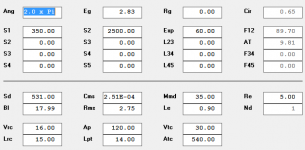
Turning the simulations into reality
I have worked out how to generate the horn shape in Autodesk Inventor. To be able to do this you need a CAD package that supports 3D parametric curves. See the attached document. I have also included .ipt file for my horn which will import into fusion.

*squareToRectHorn.zip includes a load of calculations for the hornprofile that might be useful
I have worked out how to generate the horn shape in Autodesk Inventor. To be able to do this you need a CAD package that supports 3D parametric curves. See the attached document. I have also included .ipt file for my horn which will import into fusion.
*squareToRectHorn.zip includes a load of calculations for the hornprofile that might be useful
Attachments
Last edited:
very interesting that the separate HF horn is preferred over the coaxial as I have heard this view from other people as well. These systems are actual quite close to my plans. However instead of the horns been ground stacked they will all be flown on a giant frame.
System calculations
I have done some basic sums to calculate the limiting factors of the system assuming that the spectrum of what we want to play is that of pink noise. Everything based on continuous ratings.
Speakers:
20 - 100: TBD sub system
100 - 500: this horn
500 - 3000: M200 on TBD horn
3000 - 20,000 Eminence N151M-8 on TBD horn

Adjusting so that the M200 is the limiting factor (ha not much of a limit) we will need a sub system capable of 142dB/1m @20Hz equivalent per side or in a mono stack 149dB/1m @20Hz. Considering the cost of that and the need to get it into a van that will probably have to be scaled back a bit...
I have done some basic sums to calculate the limiting factors of the system assuming that the spectrum of what we want to play is that of pink noise. Everything based on continuous ratings.
Speakers:
20 - 100: TBD sub system
100 - 500: this horn
500 - 3000: M200 on TBD horn
3000 - 20,000 Eminence N151M-8 on TBD horn
Adjusting so that the M200 is the limiting factor (ha not much of a limit) we will need a sub system capable of 142dB/1m @20Hz equivalent per side or in a mono stack 149dB/1m @20Hz. Considering the cost of that and the need to get it into a van that will probably have to be scaled back a bit...
Attachments
How big was that van, kip?
Edit:
And what kind of budget are you talking about for the low end?
Biggest problem is the ports probably...
Edit:
And what kind of budget are you talking about for the low end?
Biggest problem is the ports probably...
Last edited:
The low end is to some extent dependent on how the current crisis goes, until we have some idea of that we can't go ahead.
Low end will be front loaded horns to match the rest of the system so no port issues, will probably target 30Hz -3dB which should be achievable by 4-6 18" FLH. Mouths will be undersized and they will split into several parts to facilitate transport. It will all have to fit into a LWB transit. Probably on the first time the system is used it will be in a smaller club so our existing subwoofers will be enough.
Low end will be front loaded horns to match the rest of the system so no port issues, will probably target 30Hz -3dB which should be achievable by 4-6 18" FLH. Mouths will be undersized and they will split into several parts to facilitate transport. It will all have to fit into a LWB transit. Probably on the first time the system is used it will be in a smaller club so our existing subwoofers will be enough.
The Terrahorn design gives some idea of what can be done with a big FLH:
The Terrahorn
Our system only needs to sub to play to 100 Hz, this allows simpler construction. We would also go with a single fold so the subs will be giant L shapes.
For amps I am probably developing my own high powered plate amps considering the expertise I have in power electronics (I have built something like a 100 kW class D amplifier before) and the amount of free time I have now. They should to ~10kW into 8 ohms burst.
The Terrahorn
Our system only needs to sub to play to 100 Hz, this allows simpler construction. We would also go with a single fold so the subs will be giant L shapes.
For amps I am probably developing my own high powered plate amps considering the expertise I have in power electronics (I have built something like a 100 kW class D amplifier before) and the amount of free time I have now. They should to ~10kW into 8 ohms burst.
- Home
- Live Sound
- PA Systems
- Mega midbass straight horn 139dB

